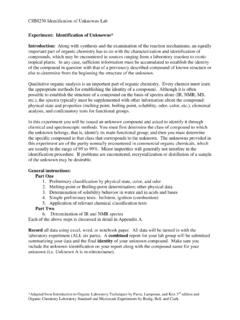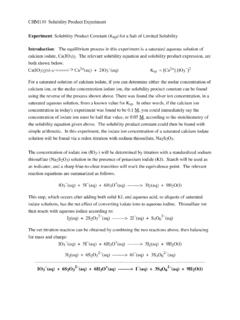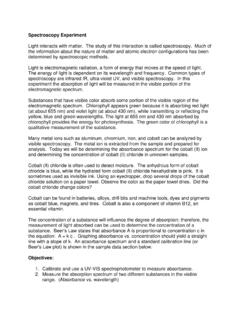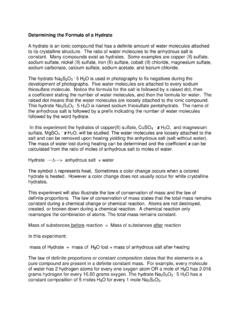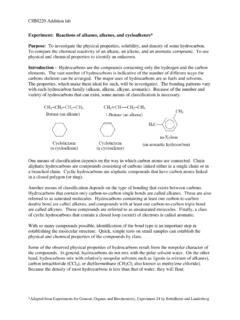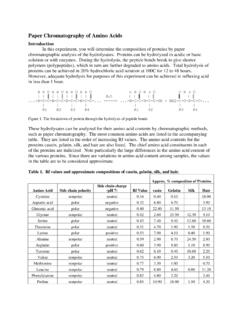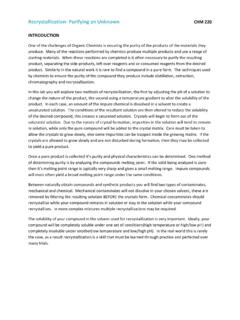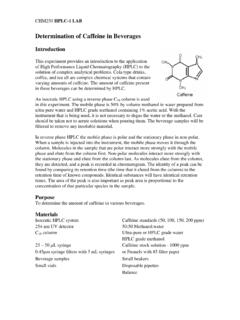Transcription of pH Measurements and Buffer Laboratory Introduction
1 CHM130 pH and Buffer lab pH Measurements and Buffer Laboratory Introduction : pH is a measure of the acidity of an aqueous solution. It is related to the concentration of hydrogen ion, H+. The pH scale can tell if a liquid is more acid or more base, just as the Fahrenheit or Celsius scale is used to measure temperature. The range of the pH scale is from 0 to 14 from very acidic to very basic. A pH of 7 is neutral. A pH less than 7 is acidic and greater than 7 is basic. Each whole pH value below 7 is ten times more acidic than the next higher value. The dissociation of water into hydrogen and hydroxide ions is the basis for the pH. scale. The pH is related to the concentration of hydrogen ions by the formula, pH = -log[H+].
2 It is a logarithmic relationship. When the concentration of hydrogen ion changes by a factor of 10, the pH changes by a factor of 1. Many chemical processes are pH dependent and careful control of pH is important consideration. Solution pH is an important property that is measured by means of a pH meter. A pH meter and its electrodes form a sensitive electrochemical device that will allow an accurate, reproducible, and reliable measurement of the pH of a solution (see Figure 1). A pH. meter is essentially a voltmeter that measures the voltage of an electric current flowing through a solution between two electrodes. There is a direct relationship between the voltage and the pH of a solution.
3 As a result, the meter on the instrument is calibrated directly in pH units. Two electrodes are required. One of them is called a glass electrode. This electrode is sensitive to the concentration of H+ ions in the solution. The other electrode is called the reference electrode and its operation is independent of the composition of the solution. The two electrodes are sometimes combined into a single entity called a combination electrode. Figure 1. pH meter and a schematic diagram of a glass electrode. Although the operating rules for a pH meter will depend on the model and the manufacturer, there are several steps that must be followed with any pH meter: 1.
4 The electrodes should always be kept in a solution except when you are transferring them from one solution to another. When you transfer them, you will want to avoid contaminating the solutions. During the transfer: (a) Rinse the electrodes with a stream of deionized water and catch the water in a beaker. (b) Remove the excess water from the electrode with tissue paper (Kimwipe). before you immerse the electrode in the next solution. (c) Do not touch the electrodes with your hands (d) Handle the electrodes with care since they are fragile 2. The pH meter must be calibrated with a solution whose pH is known before you can measure an unknown pH with accuracy.
5 These solutions of known pH are called Buffer solutions. 3. You should be able to read the pH of a solution about 10 seconds after the electrode(s). have been immersed. The reading should be steady and not suddenly changing. If sudden changes do occur, consult your Laboratory instructor. 4. If the Denver Instruments pH meter does not list 4, 7, and 10 on the display, the meter needs to be calibrated. Click Here for Calibration instructions. See the Calibration instructions for the SPER Scientific pH meter to check the calibration status. The pH of a solution can affect both the spontaneity and the rate of chemical reactions. The ability to control the pH of a solution is, therefore, of fundamental importance.
6 Because many cellular processes can result in the generation of acids or bases, organisms must have a way to regulate the pH of cellular and extracellular fluids. In general this is accomplished through the use of buffers, or solutions that resist a change in pH. Buffer solutions contain a weak acid and its conjugate base, or a weak base and its conjugate acid, such that the resultant solution resists change in pH. The identities of the Buffer components and the relative amounts of the weak acid and conjugate base (or weak base and conjugate acid) dictate the pH of a Buffer . This is most easily observed through the Henderson-Hasselbalch equation which relates the pH of a Buffer solution to the pKa of the acid component and the concentrations of the weak acid and conjugate base (or weak base and conjugate acid).
7 It is important to note that the concentrations present in the Henderson-Hasselbalch equation represent the initial concentrations of the acid and base components of the Buffer , without consideration of equilibrium effects (this means that the small x approximation is assumed to be valid for both components of the Buffer ). It is always important to check whether or not this assumption is valid when using the Henderson-Hasselbalch equation for quantitative pH calculations. This experiment seeks to examine various aspects of Buffer solutions. Two Buffer solutions (either the acetic acid/acetate system or the ammonia/ammonium system) will be generated.
8 By measuring the pH for these solutions, the validity of the Henderson-Hasselbalch equation can be gauged. Additionally, by adding strong acid and strong base to various solutions, the ability of Buffer solutions to resist changes in pH relative to water will be assessed. Finally, the impact of dilution on the pH of solutions of Buffer components will be examined. From these results, the effect of dilution on a Buffer can be inferred. This exercise will focus on the use of the pH meter and its standardization and the measurement of the pH of various aqueous solution. pH will also be converted to the concentration of hydrogen and hydroxide ion the solution.
9 You will also explore properties of Buffer solutions. Materials: This exercise will require the use of the following glassware and hardware: 1. Test tubes 2. Beakers 3. Pipets and burettes 4. pH meter 5. data sheet: This exercise will use the following chemicals: 1. Standard Buffer solutions of pH 4, 7 and 10. 2. Aqueous ammonia and ammonium chloride solid. 3. Aqueous HCl and NaOH. 4. acetic acid 5. solid ammonium chloride 6. solid sodium acetate 7. ammonia solution Procedure This exercise contains two parts, pH Measurements and Buffer Preparation. Each part has separate pages of instructions and a sheet in a workbook to enter collected data and make calculations.
10 The Excel spreadsheet should be down loaded to the Laboratory computer and opened from its hard drive during the experiment. Part One pH Measurements 1. Standardization of the pH Meter Check with the instructor to see if CALIBRATION is necessary. If the Denver Instruments pH meter does not list 4, 7, and 10 on the display, the meter needs to be calibrated. Click Here for Calibration instructions. See the Calibration instructions for the SPER Scientific pH meter to check the calibration status. 2. pH Measurements Measure the pH of the solutions indicated on the spreadsheet and record the values to the hundredth of a pH unit. Each solution should be in a 50mL.
